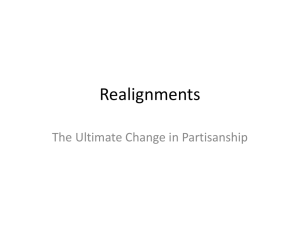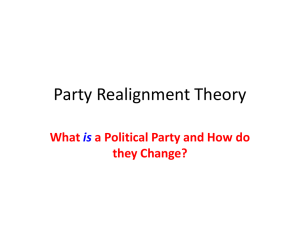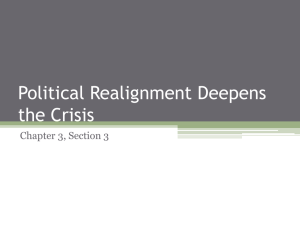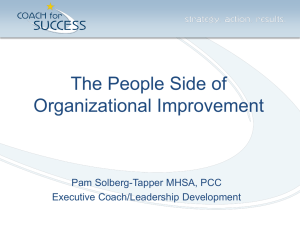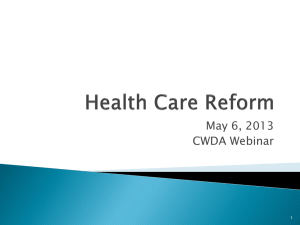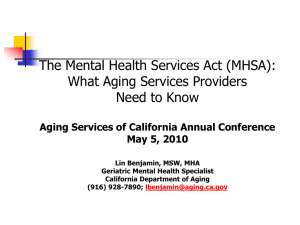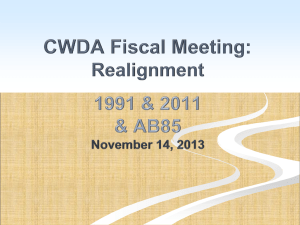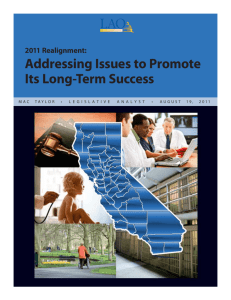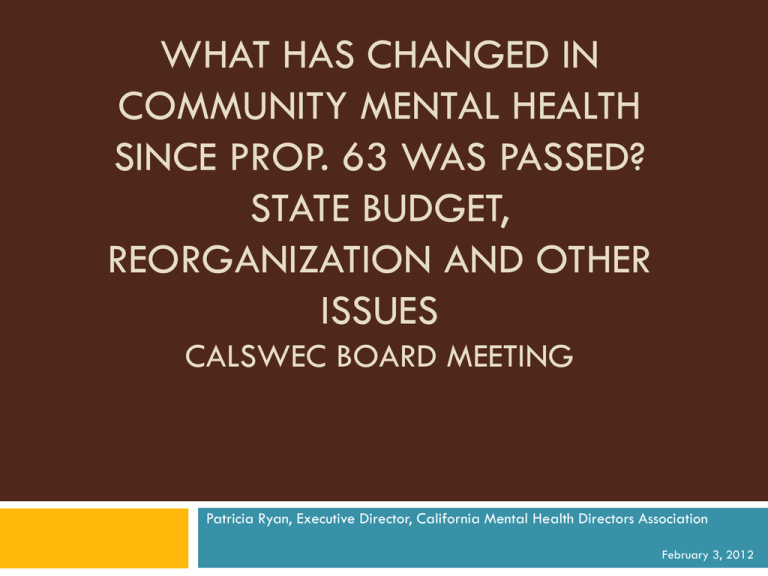
WHAT HAS CHANGED IN
COMMUNITY MENTAL HEALTH
SINCE PROP. 63 WAS PASSED?
STATE BUDGET,
REORGANIZATION AND OTHER
ISSUES
CALSWEC BOARD MEETING
Patricia Ryan, Executive Director, California Mental Health Directors Association
February 3, 2012
Changes
The question should be, what
HASN’T changed since 2004?
Outline
How Funding Structure Has Changed
Federal Health Reform: the Accountable Care Act of
2009
Mental Health Parity
2011 Realignment
AB 109: Public Safety Realignment
AB 100: Changes to the MHSA
State Administration Reorganization
What’s Next? Questions for Counties and CalSWEC to
Ponder
How Funding Structure Has Changed
The MHSA = A Growing Percentage Statewide for
Direct Services
Community Mental Health Funding
FY 2004-05
($3.1 Billion)
MHSA
Other
Other SGF
Managed Care
SGF
Realignment
EPSDT SGF
FFP
The MHSA = A Growing Percentage Statewide for
Direct Services
Estimated* Community Mental Health Funding
FY 2011-12
($4.6 Billion)
Other
One-Time MHSA
Realignment
MHSA
FFP
* Based on Governor's Proposed FY 2011-12 Budget
Federal Health Reform
Affordable Care Act of 2009:
More People will be Covered
Provides tax credits and government subsidies for people
(individuals, families, and adults without children) with incomes
133% - 400% of the federal poverty level.
Employers with 200+ employees will have to offer health
benefits to all (including low-income employees).
Medicaid Expansion (2014): Covers single adults up to 133 %
of federal poverty
Those employers with at least 50 employees will be required
to pay a fine if they don’t offer health insurance (including
fining waiting periods).
Expanding Coverage - Medicaid
Medicaid expanding eligibility (as of 2014) with
feds picking up 100% share of cost for those under
65 who are at or below 133% the Federal Poverty
Level
This means: $14,404 individual income and $29,326
family of four income.
Includes an estimated 16 million new people nationally,
1/5 or more are likely to have mental illness and/or
substance use disorder service needs.
The Congressional Budget Office estimates almost a
quarter of Americans who lack health insurance today will
be covered under Medicaid over the next 10 years.
CA’s 1115(b) Waiver
California has received approval for a new 5-year Medicaid
waiver (2010-2015) as a “bridge to federal reform”
The new waiver began in November and will be implemented
over the course of 2011 and throughout the demonstration
period.
Under the “Managed Care Expansion (MCE)” provision, counties
may provide the match to expand coverage to individuals up to
133% of federal poverty before 2014 and receive 50% federal
matching dollars. It is optional for counties to participate, and they
may set their own eligibility level (for example, all eligible
individuals up to 100% of FPL).
If savings are achieved & milestones met, it could bring as much
as $10B in new federal funds to support expanded coverage,
access to care, improvements in health care delivery.
Minimum MH Benefits Required in
1115(b) Waiver
For MCE enrollees (under 133% of FPL), each participating
county must provide the following minimum package of mental
health benefits:
Up to 10 days per year of acute inpatient hospitalization in an
acute care hospital, psychiatric hospital, or psychiatric health facility.
Psychiatric pharmaceuticals.
Up to 12 outpatient encounters per year. Outpatient encounters
include assessment, individual or group therapy, crisis intervention,
medication support and assessment. If a medically necessary need
to extend treatment to an enrollee exists, the plan can optionally
expand the service(s).
Substance Use Services are Optional in MCEs.
Federal MH/SA Parity
Mental Health & Substance Use
Coverage – Parity
MH & SU Services must be provided at parity with general
healthcare services. This prohibits discrimination of MH/SU
against medical/surgical coverage.
“Parity” means:
Coverage restrictions cannot differ from medical or surgical
coverage charges (copayments, deductibles, etc)
Lifetime limits/costs must be the same
Limits on treatment (number of doctor visits or hospital days
covered) must be the same.
Parity is included within a range of areas:
Large Employers – Parity Act
Medicaid – Parity Act and Health Care Reform Legislation
Health Insurance Exchanges for Individual and Small Group
Policies – Health Care Reform Legislation
Medicare – Medicare Improvements Act (MIPPA)
2011 Realignment
“Decisions are best made closer to the people, not in
Sacramento... by those who have the direct knowledge
and interest to ensure that local needs are met in the
most sensible way.” – Governor Jerry Brown
2011 Realignment
The primary
vehicle for
2011 Public
Safety
Realignment
is AB 118,
which creates
the account
structure and
initial
allocations.
Funding Source (~$5.5 billion/year)
1.0625%
of existing sales tax revenue
Continuously appropriated to counties
Account Structure for FY 2011-12 at
state and county levels
Eight
accounts, nine subaccounts
One account is a “Mental Health Account”
Programs Realigned to Counties
Court Security
Local Public Safety
Subventions
Local Jurisdiction of
Lower‐level Offenders and
Parole Violators
Adult Parole
Foster Care, Child Welfare
Services, Adoptions
Assistance Program, Child
Abuse Prevention
Adult Protective Services
Community Mental Health
EPSDT *
MH Managed Care *
1991 MH Realignment
Substance Use Treatment
Women and Children’s
Residential Treatment Services
Drug Court
Nondrug Medi‐Cal Substance
Abuse Treatment Services
Drug Medi‐Cal
*Not realigned until 2012-13
Realignment Funding for Mental
Health
2011-12
2012-13
EPSDT
0 (AB 100)
$544 million
Medi-Cal MH Managed Care
0 (AB 100)
$188.8 million
(Proposed*)
1991 Community MH Realignment $1.083 billion $1.164.4 billion
Since AB 100 diverted MHSA funding in 2011-12, Medi-Cal
Specialty Mental Health not realigned until 2012-13.
Only the funding source for 1991 community mental health
realignment changed. Funds will be deposited monthly.
New FY 2012-13 Proposed Baseline Allocations
for Realigned Mental Health Programs
In total, reduced by $34.9 M in new figures.
Critical to determine adequacy of baseline figures.
EPSDT impacted by Katie A., Healthy Families
proposal.
2011-12
New
Original
Figures
Figures
Mental Health
Managed Care
EPSDT
1991 MH
Responsibilities
2012-13
New
Original
Figures Figures
2013-14
New
Original
Figures Figures
2014-15
New
Original
Figures Figures
-
-
$183.7
$188.8
$183.7
$188.8
$183.7
$188.8
-
-
$629
$544
$629
$544
$629
$544
$1,083.6
$1,104.8
$1,119.4 $1,164.4 $1,119.4 $1,164.4 $1,119.4 $1,164.4
AB 109: Public Safety Realignment
Effective October 1, 2011.
Statewide $354.3 million available in FY 2011-12
for two components:
Local
custody, alternative custody, and alternative
supervision services for new adult offenders that are
either non-violent, non-serious, or non-sex offenders.
Post-release community supervision for adults paroled
out of state prison (excluding violent, serious, 3rd strike,
high risk sex offenders).
Public Safety Realignment from the
County Behavioral Health Perspective
County mental/behavioral health directors are in the midst of
working at the local level with their probation departments in
developing their Community Corrections Partnership Plans
pursuant to AB 109 – the public safety realignment of low
level parolees from the state to the local level.
The state provided funding for these parolees, and counties
must determine how to make the best and most costeffective use of the limited funding to help limit avoid
recidivism.
Many of these parolees have mental health issues and/or
substance use disorders that require treatment.
AB 100: MHSA Changes
AB 100: MHSA Changes
Deleted requirement that the Department of Mental Health
(DMH) and the Mental Health Services Oversight and
Accountability Commission (MHSOAC) annually review and
approve county plans and updates.
Deleted requirement that a county annually update the 3-year
plan but still required that there be updates.
Specified that the “state” instead of DMH will administer the
Mental Health Services Fund (MHSF), and issue regulations.
Required that starting July 1, 2012 the Controller shall
distribute on a monthly basis to counties all unexpended and
unreserved funds on deposit in the MHSF as of the last day of
the prior month.
Specifies that “unreserved funds” are those funds that are not
held in trust or are not set forth in component allocations.
AB 100: MHSA Changes
Reduced the state administrative funds reserved for
DMH, MHSOAC, California Mental Health Planning
Council (CMHPC) and other state agencies from five
percent (5%) to three and half percent (3.5%).
Provided for a one time (2011-12) transfer of $862M
from the MHSF, which is not subject to repayment, to be
distributed in the following order:
$183,600,000 for Medi-Cal Specialty Mental Health
Managed Care;
$98,586,000 for mental health services for special
education pupils (formerly referred to as AB 3632);
$579,000,000 for Early and Periodic Screening, Diagnosis and
Treatment (EPSDT).
AB 102: Transfer of Medi-Cal
Specialty MH/SU Administration
Legislative
Intent in AB
102
Improve access to culturally appropriate
services
Effectively integrate financing of services
Improve state accountability and outcomes
Provide focused, high- level leadership for
behavioral health
Other State Administration
Reorganization Proposals
DMH Functions Transferred to DHCS
MHSA-Specific Functions
MHSA state level issue
resolution
Other Functions
Financial oversight
County data collection,
reporting
Suicide prevention
Stigma and discrimination
Student Mental Health
Initiative
Certification, compliance,
quality improvement
Co-occurring disorders
MHSA housing
Veterans mental health
Training contracts
SAMHSA, PATH grants
CA Health Interview Survey
MH Planning Council
DMH Functions Proposed to be Transferred to
Other Departments/Organizations
OSHPD: MHSA WET Regional Partnerships,
CalSWEC Stipend Program, Statewide Technical
Assistance Center (Working Well Together
Collaborative), Psychiatric Residency Program
Department of Public Health: MHSA Reducing
Disparities Project, Other Cultural Competency
Functions; MH Facilities Licensing
MHSOAC: Client and Family Member Contracts
What’s Next? Questions for Counties
to Ponder
What is the role of the counties with HCR, parity and the 1115
waiver in the context of realignment?
Will HCR require a change in county structures?
How will HCR, parity, realignment and the 1115 waiver impact
our system’s capacity to provide mental health and substance
use services?
How will MH/SU advocates ensure that sufficient resources
and progressive models of service remain available for the
populations that we serve?
How can we both protect MHSA resources, and use them
strategically to create and maintain the best communitybased, recovery-oriented mental health system possible in the
context of all of this change?
Expanding County Responsibilities
and Maximizing Leadership
Counties are providing services during a historic change to
the structure and function of state and local government.
Local programs will now lead the development and
implementation of services resulting from healthcare reform,
public safety realignment, economic restructuring etc.,
They (counties) must take charge of their own destiny and
develop new relationships among themselves (e.g., regional
partnerships), the state and other relevant partners.
CalSWEC Leadership Must Consider
How counties and educational programs will meet growing behavioral
workforce development and training needs? What is CalSWEC’s role?
Will CalSWEC work with MSW programs and employers to prepare
qualified students who are work ready in future integrated
health/behavioral health settings brought about by Health Care Reform?
Can MSW programs become integrated, linking Title IVE services with
mental health services, especially in the context of the Katie A. settlement?
How MSW programs will pay more attention to new proactive models that
address adult and juvenile justice, substance use/co-occurring disorder
populations, cross disability populations, prevention and early intervention,
etc.
Recommendations
Become organizationally informed of the changing governance and
financing occurring statewide. CalSWEC must communicate sustainability,
through long term strategies that recognize the new roles of county mental
health, DHCS, CalSWEC, CalMHSA, OSHPD or others.
Work more closely with county mental/behavioral health and provider
organizations to identify local workforce, education, and training needs to
ensure quality among graduates and maintain credibility among employers.
Recognize and teach new proactive models that are emerging , such as
integrated healthcare, collaborations between child welfare and mental
health, local criminal justice and substance use/co-occurring populations.
Develop a stronger MSW curricula focus on management practice and
policy, e.g., funding for MH/SU services.
An area of potential mutual interest and partnering opportunities is
documenting the positive outcomes of MHSA WET Funds.


